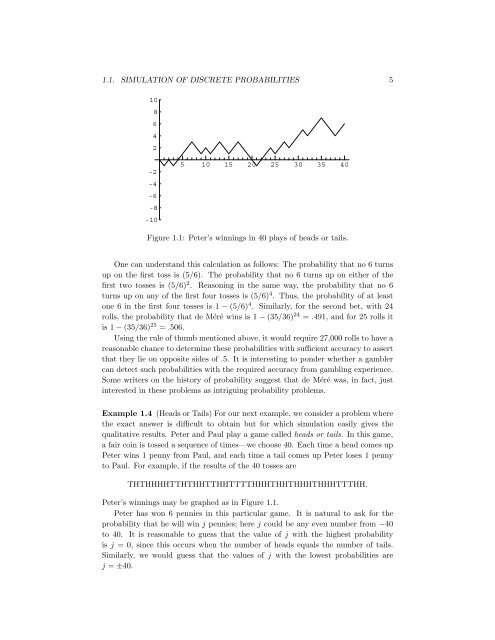Chapter 1 Discrete Probability Distributions - DIM
Chapter 1 Discrete Probability Distributions - DIM
Chapter 1 Discrete Probability Distributions - DIM
- No tags were found...
You also want an ePaper? Increase the reach of your titles
YUMPU automatically turns print PDFs into web optimized ePapers that Google loves.
1.1. SIMULATION OF DISCRETE PROBABILITIES 5108642-2-4-6-8-105 10 15 20 25 30 35 40Figure 1.1: Peter’s winnings in 40 plays of heads or tails.One can understand this calculation as follows: The probability that no 6 turnsup on the first toss is (5/6). The probability that no 6 turns up on either of thefirst two tosses is (5/6) 2 . Reasoning in the same way, the probability that no 6turns up on any of the first four tosses is (5/6) 4 . Thus, the probability of at leastone 6 in the first four tosses is 1 − (5/6) 4 . Similarly, for the second bet, with 24rolls, the probability that de Méré wins is 1 − (35/36) 24 = .491, and for 25 rolls itis 1 − (35/36) 25 = .506.Using the rule of thumb mentioned above, it would require 27,000 rolls to have areasonable chance to determine these probabilities with sufficient accuracy to assertthat they lie on opposite sides of .5. It is interesting to ponder whether a gamblercan detect such probabilities with the required accuracy from gambling experience.Some writers on the history of probability suggest that de Méré was, in fact, justinterested in these problems as intriguing probability problems.Example 1.4 (Heads or Tails) For our next example, we consider a problem wherethe exact answer is difficult to obtain but for which simulation easily gives thequalitative results. Peter and Paul play a game called heads or tails. In this game,a fair coin is tossed a sequence of times—we choose 40. Each time a head comes upPeter wins 1 penny from Paul, and each time a tail comes up Peter loses 1 pennyto Paul. For example, if the results of the 40 tosses areTHTHHHHTTHTHHTTHHTTTTHHHTHHTHHHTHHHTTTHH.Peter’s winnings may be graphed as in Figure 1.1.Peter has won 6 pennies in this particular game. It is natural to ask for theprobability that he will win j pennies; here j could be any even number from −40to 40. It is reasonable to guess that the value of j with the highest probabilityis j = 0, since this occurs when the number of heads equals the number of tails.Similarly, we would guess that the values of j with the lowest probabilities arej = ±40.
















